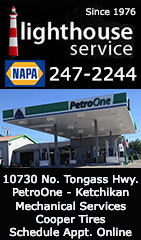75 Hours at Sea on the ColumbiaEnd to end in Southeast Alaska, Possibly for the last timeBy DAVE KIFFEROctober 20, 2019
"My gosh," she said. "I didn't even know we still had a ferry system." A lot of locals have gotten used to not using the ferry system to get around. It is just quicker, and in some cases cheaper, to fly these days. And in today's world, people don't seem to travel within Southeast as often as they used to. We no longer have the ties we had with people in places like Wrangell, Petersburg and Sitka and, if we do, we seem to think that keeping up with them on Facebook is somehow good enough.
So, when we travel, we hop a jet to Seattle or Anchorage, swearing all the way about the uncomfortable seats, the Transportation Safety Administration hassles and the lack of anything resembling actual food. Meanwhile, the ferries - at least for now - continue to sail past us, offering a different option, offering something more like the travel that we grew up with, the travel that once marked our lives in Southeast Alaska and our connections to the Outside world, either through Prince Rupert or Seattle. Of course, now the southern connection is Bellingham, a decision the state made three decades ago that still rankles anyone who wants to get somewhere and not be dumped off hours away from Seattle. And as for Prince Rupert? To use a common social media phrase: It's Complicated. Late in the summer, the state announced it was ending Prince Rupert service at the beginning of October, cutting the ties between Ketchikan and its closest sister city, a city that probably has more in common with Ketchikan than any other place, but has watched that the connection wither over the last couple of decades as the ferry service has been cut further and further, until the final trip, the first week of October, was a completely depressing anti-climax. I thought about taking the last trip to Rupert. But, it was too short to seem worth the money, and it would have been too sad, in light of the many times I have made that trip in the past, in rapt anticipation of "getting of the rock" for one good reason or another. And so the last trip was made to Prince Rupert, but without me. Then just this past week, the state announced there would be at least two more runs to Prince Rupert, one in October and one in November and that it hoped that a long term solution could be reached. I've long since given up getting any good long-term ferry options from the people who decide the fate of the Marine Highway. The purse strings keep getting cut by people demanding the AMHS "make money" and yet they dump millions of dollars into maintaining the highways of the "rail belt" without an inkling of making those roads "pay for themselves" Anyway, I decided to take - in mid-September - one of the last trips on the largest ferry, the Columbia, which is now laid up for the winter. It may never come back on-line. A few years ago, the Taku went into lay-up and never came back. It sat sadly in Ward Cove for a couple of years before it was finally sold for scrap last year. I had always meant to take a final trip on the Taku, which was the first ferry I remember traveling on in the early 1960s, but I never did. So I decided to take an end-of-the-season trip on the Columbia. The rumor mill, which has been the best place to get accurate Alaska Marine Highway System info for some time, says that the state plans to try to sell the Columbia off because it is the most expensive ship to run and if there is any clear direction in the current AMHS it is in any direction that will save money in the short-term, even if the long term costs could be catastrophic to the coastal Alaska, including Southeast. You can clearly see that in the new winter schedule which basically cuts off places like Cordova, Kodiak and Dutch Harbor for months at a time. It is part of a clear, unspoken policy of choking off the system, making it expensive and its schedule unreliable, and then saying "hey nobody rides the ferries, let's get rid of them."
There are also rumors that - also in order to save money - the state will begin carving up the longer runs into shorter runs because vessel and crew costs are lower on day, or shuttle, ferries. The two newest ferries, the Tazlina and the Hubbard, are such short run ferries, designed to make the Lynn Canal run between Juneau and Haines/Skagway. No staterooms, limited passenger amenities, Basically the Staten Island Ferry with a car deck and better views out the windows. So, if I wanted to get on one ferry and go from Ketchikan to Skagway and back in three and a half days of isolated ocean bliss, my window of opportunity was closing. I swallowed the fact that fare and state room was half again as much as a plane ticket and hopped on, early on a Sunday morning heading north. Yes, I could have saved a bundle by not getting a stateroom. But I am not that young, adventurous traveler anymore. I don't want to pretzel myself into an observation lounge chair. I don't want to lay in a sleeping bag on the hard deck. And I especially don't want to huddle in the cold Solarium, especially this time of year as the temperature is dropping. I was never a solarium person anyway. I like my privacy. I don't like other people talking, a mediocre guitar player strumming, or any number of people blowing pot in my face. Anyway, there is something almost womb-like about being in ferry stateroom by one's self. The engine rumbles, the superstructure shakes as the ship turns, it is almost impossible to not sleep more than you were intending to. And there is nothing to interrupt you from finishing those books you've been meaning to get to for the past several months. Riding the Columbia, in some ways, is like traveling on a dinosaur, but in a good way. The pace of your trip is not the pace of the modern world. You will get where you are going in days rather than hours. And you will get there when you get there. Maybe your ship will arrive on time, or maybe a little later, maybe even a bit early. You are not worried about making connections or running headlong through airports. When you choose to eat it will be in a cafeteria, or on the Columbia, a semi-formal dining room. You will never have the person in front of you slam his seat into your face. You will never have the food cart smash into your arm because the oversized person in the middle seat is pushing you into the aisle. You will travel in relative comfort. No matter how fat your pocketbook is. You will watch out the windows as the same island passes by for hours rather than seconds. You will see the water, the trees, the mountains, until it gets dark, and then you will see nothing as you traverse the seemingly empty black hole which is nighttime in the Southeast wilderness, only rarely punctuated by the light of civilization. On the way up, the ship seems empty, spookily so. There is a Roads Scholar group on board and a few small families. And, of course, a bunch of solitary travelers, many looking as though they would never pass muster with the TSA. You can wander around the ship public spaces and everything is quiet, except for the occasional messages to look starboard or port for whales and porpoises. The weather is good, Clarence Strait is as flat as a sheet of glass, there is no ocean swell and the only waves are from the Columbia's wake. After six hours, you pull into Wrangell and a few people get on and a few get off. Then you transit Wrangell Narrows, noting that the lights aren't nearly as dramatic in daytime. Then you arrive in Petersburg and once again - this time of year - there is only a handful of people coming and going. After Petersburg, in the dark, you feel the ship begin to veer off course and the pulse of the engine changes. Then all is silent and you realize the boat is no longer going forward. The Columbia has pulled into Farragut Bay and is there for more than an hour. At one point you hear one of the boats being lowered and you wonder if it is a crew drill. Later, you find out that that some flares were spotted in the bay and the crew took part in a potential search and rescue. Some hunters at a cabin on the Farragut River had decided to shoot off some old flares and the Coast Guard - and the Marine Highway - responded. It is not unusual for a state ferry to deviate from its run for a rescue mission. This summer, one ferry helped rescue the crew of a sinking boat in British Columbia. As we cut back on the ferry system, we lose this constant sentinel on our waters. It is an eight-hour run from Petersburg to Juneau. Air travel has made us forget just how far apart Southeast communities actually are. You get in a jet and fly over the emptiness in minutes and it seems like Wrangell or Sitka or Juneau is as close as the other side of town. The ferries remind us this is NOT the case. Even at 20 mph, the hours pass between towns. You see the endless chain of islands, the relentless rainforest and the mountain ranges that divide us. You are reminded that our little communities are indeed islands in the giant world. For all the interconnectedness in the modern world, we are really on our own. Except for the connections that we create. Such as the Alaska Marine Highway. This is hammered home because the digital world, for the most part, does not exist in the Marine Highway. There is no on board WIFI. There are vast stretches of the Panhandle where cell phones don't work. For some this is unbearable. They can't handle being out of touch for hours. If they are not constantly texting or posting, they apparently cease to exist. For me, it is freaking wonderful to be out of touch like that. Yes, I like my Facebook and I like being able to check in with what is going on in the Outside World, occasionally. But having the phone not ring is a gift. And having nothing but time to read and write is truly a Godsend, compared to my normal life. I realize that this makes me sound somewhat like a hermit or at least an introvert. But a ferry stateroom will always be one of my "happy places." For the most part, the only time you get much cell service is when you are in a port. But even Juneau and Sitka, with their terminals located "out the road" seemed to have almost no cell coverage when we docked. Oddly enough, there seemed to be plenty of "bars" as we cruised the wilderness of Chatham Strait for several hours. Go figure. So, there was "nothing" to do but hang out in the stateroom or roam the decks a bit. Since the bars and the gift stores and the video arcades have closed, that pretty much leaves the solarium for giggles and grins. It is always fun to check the broad slice of life in the solarium as long as you aren't stuck living with it for 24 hours. This trip there were the usual folks curled up in sleeping bags or tents, sleeping fitfully like hobos riding the rails. There was, indeed, someone playing the harmonica, and not at all well. There were kids running about and someone was putting together a kite to send aloft. The weather almost made the solarium seem like a good option. Almost.
At times, at least on the trip north, it felt like there were more crew on board than passengers and this is what probably bothers the state bean counters the most, many of the cutbacks in recent years have been couched as money saving. The closures of the bars and the gift shops for example. But their removal comes off as just sterilizing an already spartan situation. Once upon a time, the socializing on board the ferries was just another sign that Southeast was a single community. Now it seems as if the state is trying to replicate down south rest stops, making the ferries as bland, as run-of-the-mill, as possible. Just about the only community left on board is the likelihood that you will know at least a few of the crew members. And those crew members continue to provide great service, as if you were actually in their own home. Which is what many of them. and us, consider the ferries to be. In general, the crew members are relentlessly chipper even in the face of labor disputes and the extreme uncertainty of future schedules and jobs. Back in the stateroom cocoon, you are immediately drowsed back to sleepy-land. Until, of course, the announcements that you are arriving in a port in the middle of the night, in this case Juneau, breaks up the reverie. One thing that hasn't changed it is always at seems as if the schedule is designed to arrive in each port at 3 am, although that is clearly the not the case. In the early days, they used to blast the horn when arriving, something we experienced every 3 am, living not far from the Ketchikan terminal. The late-night arrivals are especially challenging in towns like Juneau and Sitka, where the terminals are many, many miles away from downtown. Cruising the Alexander Archipelago it is almost impossible to keep from pondering all the various attempts to bridge it. Sometimes literally. In the 1930s, the Federal Government did preliminary surveys on a coastal road from Seattle to Skagway. That idea, no matter how impractical, stayed on the drawing board until the Alaska Highway was punched through in World War II. One plan called for more than 130 bridges to be built. We in Ketchikan know just hard it is to get one bridge built. In the 1960s, 70s, and 80s there were plans to de-isolate some of the communities with roads from Ketchikan and Wrangell up the Stikine or Unuk Rivers or even the Bradfield Canal. As late as the early 1990s, there were still efforts being made to promote a road up the Bradfield Canal to hook into the Cassiar Highway in Canada. Even though, as that point, the Canadians were showing no interest in building the Canadian portion of the connecting road. They still aren't. Of course, the endless capital move agitation also brought efforts to build roads between Juneau and Haines/Skagway in order to blunt the Juneau "Isolation" argument. When you sail slowly, deliberately up the eastern shore of Lynn Canal, and you watch the waterfalls cascade sharply down the near vertical glacier topped mountains, you realize that any Lynn Canal road would have been an expensive, avalanche-riddled folly. Then in the mid-1990s, the state decided the best plan was buy expensive "fast" ferries to shorten trips between Sitka/Haines/Skagway and the rest of Southeast. Neve rmind that British Columbia was already abandoning its fast ferry fleet as unworkable. We in Alaska, of course, would do fast ferries "better and smarter." We didn't. And now the state is looking for any buyer for the Chenega and the Fairweather and both ferries appear to be permanently laid up in Ward Cove. In the early 2000s, the state returned to the idea of roads in the Tongass, supplemented by feeder ferries. It would cost billions of dollars punch roads across such places as Baranof Island and the Cleveland Peninsula, and with delays for shuttle ferry service, it would actually take longer than the regular ferry runs, but - as usual - facts on the ground were in short supply in the discussion process. Those efforts also generally went nowhere. Efforts to shorten the distance between Ketchikan and the Canadian road-system to the south were also looked at as the Canadians pondered building their own bridge to the Tsimpshian Peninsula and running a road up to the Lax-Kw'alaams (formerly Port Simpson), but that proved to be too expensive. Now we are facing no Canadian service at all. It used to be an assumed part of Revilla life, that you could catch a six-hour ferry from Ketchikan to Rupert, get on the road system and drive wherever you needed to go on the continent. Now, we are looking at going all the way to Bellingham, at a substantial cost for car and stateroom, not a great option. Unless we want to backtrack all the way to Haines and Skagway, putting you days further from the road system you are trying to reach. Speaking of the other end of the Panhandle, you finally arrive in Haines and Skagway, two of the three places in Southeast (Hyder is the other) where you can actually drive to civilization. There are still discussions about extending the Juneau road system farther north and then using the Tazlina and the Hubbard as shuttle ferries. The most recent proposal calls for building a new Juneau ferry terminal in Berners Bay in order to shorten the Lynn Canal run. One hopes that does not mean closure of the Auke Bay terminal. You already need a bank loan to take a taxi from Downtown Juneau to Auke Bay, you would need a second mortgage to go the 37 miles from Juneau to Berners Bay. Once again, what saves money - in this case run time - for the marine highway comes with a significant additional cost for users. Coming back down from Skagway and Haines, you see Lynn Canal flat calm and wonder about the past when ships wrecked here frequently like the Princess Sophia and the SS Islander. It was the carnage of bad weather and creaky ships during the Klondike Gold Rush and later that caused the Lighthouse Service to finally take navigating in the Inside Passage seriously enough to build lighthouses and at least try to mark as many hazards as possible with buoys and lights. It's been quite a while since there has been a major grounding in the area - at least of passenger ships. And now riding a ferry seems as safe as going for a walk. It was only a couple of generations ago that taking a steamship in SE was not. The ferry is much more crowded going south in September. The car deck appears nearly full as people head south for the winter. The Road Scholar folks are still on board, enjoying a round trip without having to be on a traditional cruise. The public spaces of the ship are much more busy, no doubt warming the lumps of the coals in the heart of some Juneau Department of Transportation bean counter.
Swinging wide to get to Sitka, you go through Peril Strait, a narrow, shallow body of water that - like Wrangell Narrows - will never be cruise ship friendly. Once again, as you imagine you can touch the trees on either side of the strait, you are reminded that you are touching Southeast Alaska and not just flying over it. Even the ferries sometimes are challenged by the narrow waterways, the late great MV Wickersham had trouble with Peril Strait and often went in the open ocean outside of Sitka. I still remember being on board when it went bow first into a spectacular Southeaster one winter, the huge ship bucking and rolling like a bathtub toy and just about everyone on board getting wildly sick! After a brief stop in Sitka, you go back through Peril Strait, made a little more challenging by having to negotiate around a Coast Guard buoy tender at work and make the long run down Chatham Strait to Petersburg. On the southern leg, you pass the entire west side of Admiralty Island, after passing nearly the entire east side going north bound. It is a reminder that there are still places in Southeast where there are more bears than people. You turn at the bottom of Admiralty into Frederick Sound just as it is getting dark and you notice a humpback whale breaching multiple times not far from Tyee Harbor, another Southeast irony, as Tyee was once the largest whaling station in the region. The slow trip allows you to think about such things, like our region's shared history. The Roads Scholar folks have finally vacated the dining room, so it is time for another reminder of how travel has changed our expectations. Once upon a time, even airlines provided meals, remember Golden Samovar Service? But now they don't. In the dining room of the Columbia you can still get a New York steak, medium rare and an acceptable mini-bottle of Merlot. All while slowly watching the best scenery in the world unspool outside the window at your table. Take that air travel. Of course, there has be at least one slightly "off" note in the dinner symphony.
There is something almost aggressively intemperate about all the little signs posted around the dining room reminding passengers to NOT tip the employees. You would swear we were at the zoo being warned to "not feed the animals." Personally, I think that AS 39.52.120(b) (2) can just go shove itself. Just another sign that the state doesn't understand the ferry system, its crew or its passengers and probably never will. Here's my tip, the ferry system workers are the best. In my 75 hours, I got nothing but smiles and professional service. It is now after dark and we are In Frederick Sound, not far from Kake, and the Columbia stops again. The engines drop down to a purr and the ship slowly rocks in its own wake for nearly an hour. It is another search and rescue? No, the ship has come upon a gigantic boil of herring and other feed in the middle of the sound. If you stand out on deck, you can hear a near constant whoosh and splash as a dozen humpback whales bubble-feed continuously. The light breeze bathes the ship in pungent "whale breath." Between the whales, you can see and hear hundreds of porpoises skittering along the surface, also chasing herring. Once again, you are hearing, smelling, almost tasting a Southeast Alaska that you can never experience in your steel bubbles at 25,000 feet. After an hour, the ship begins to move again. Following a path that the Alaska Marine Highway System has followed for nearly 60 years. A path that unfortunately could come to an end, because Alaska's Anchorage -Wasilla axis has forgotten that "roads" are not just a patch of asphalt in most of the rest of Alaska. You head south for another day, through Petersburg, Wrangell Narrows and Clarence Strait, arriving back in Ketchikan. It has been the smoothest sailing imaginable, particularly for a fall in Southeast Alaska. If only the future of the Alaska Marine Highway System could be such “fair seas and following winds.”
On the Web:
Contact Dave at dave@sitnews.us Dave Kiffer ©2019 Publication fee required. © Representations of fact and opinions in comments posted are solely those of the individual posters and do not represent the opinions of Sitnews.
|
||||||||









